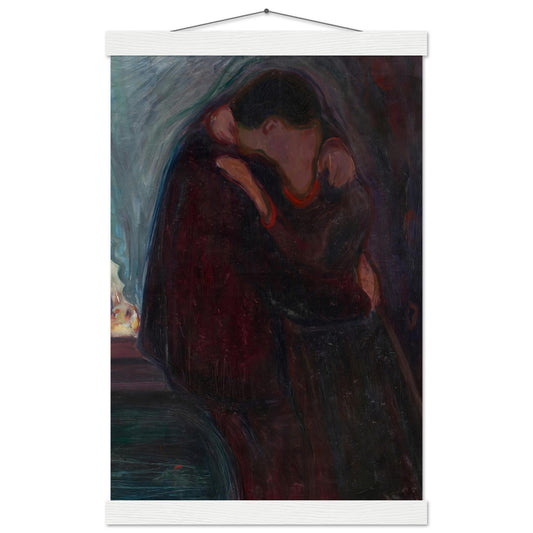Collection: Edvard Munch - "The Kiss" (1897)
Edvard Munch's 1897 oil on canvas painting, "The Kiss," is a powerful representation of the intense emotions and complex dynamics within romantic relationships. The painting features a couple locked in a passionate embrace, their faces merging into one indistinguishable form. This visual blending symbolizes the profound unity and loss of individual identity that often accompanies deep romantic love. Munch's use of dark, moody tones and flowing, almost ethereal lines creates a sense of mystery and introspection, inviting viewers to contemplate the nature of love and human connection.
In "The Kiss," Munch employs his characteristic expressionist style to convey the emotional depth and psychological intensity of the moment. The figures are depicted with a raw, almost haunting quality, reflecting Munch's exploration of existential themes such as love, anxiety, and mortality. The background, with its swirling, abstract patterns, further enhances the dreamlike atmosphere of the painting, suggesting the couple's isolation from the external world and immersion in their private emotional experience. This technique not only highlights the intensity of their bond but also underscores the transient and often tumultuous nature of love.
Munch's "The Kiss" is a poignant exploration of the complexities of romantic relationships and the human psyche. The painting's ambiguity, with the merging faces and indistinct forms, allows for multiple interpretations, reflecting the viewer's personal experiences and emotions. Whether seen as a celebration of love's unity or a commentary on the loss of self within a relationship, "The Kiss" remains a compelling and evocative work of art. Munch's ability to capture the essence of human emotion through his unique artistic vision has cemented this painting as a significant piece in the canon of expressionist art.
-
Classic Semi-Glossy Paper Poster
Regular price $24.99 USDRegular priceUnit price / per -
Museum-Quality Matte Paper Poster with Hanger
Regular price $64.99 USDRegular priceUnit price / per -
Aluminum Print
Regular price From $49.99 USDRegular priceUnit price / per -
Acrylic Print
Regular price From $69.99 USDRegular priceUnit price / per









